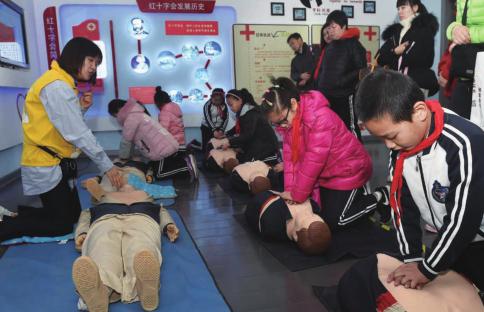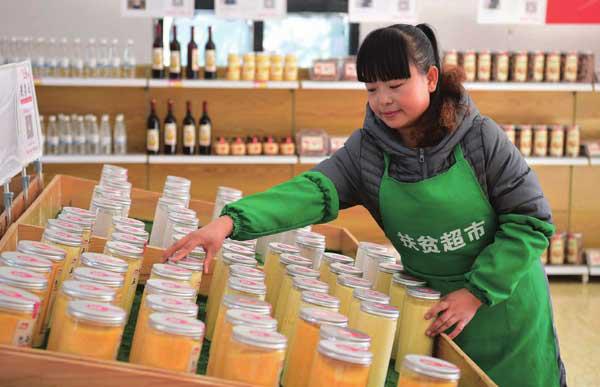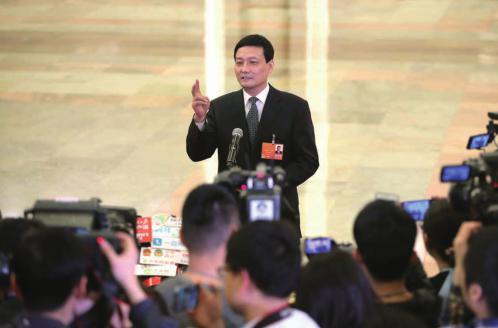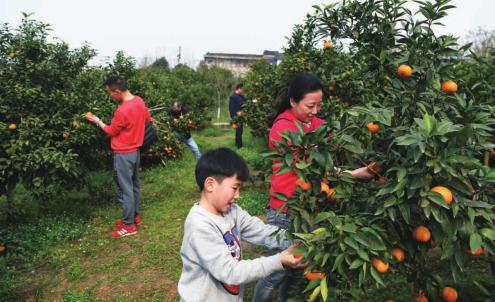Tree Planting Day

Children water a tree at a kindergarten in Jishui County, east Chinas Jiangxi Province, on March 12, the countrys 40th Tree Planting Day.
Pollution Being Defeated
China is winning its war on pollution after four years of battle, a U.S. study said on March 12.
The concentration of fi ne particulates in Chinese cities has decreased by an average rate of 32 percent since 2014, according to research undertaken by professors at the University of Chicago.
Data from nearly 250 Chinese offi cial monitoring agencies was analyzed with positive fi ndings.
“The data shows China is winning its war against pollution,”said Michael Greenstone who conducted the study and is Director of the Energy Policy Institute at the University of Chicago (EPIC).
New data released by the Chinese Government in March showed that the number of “severely polluted” days in Beijing dropped to 23 in 2017, compared with 58 in 2013.
Across the country, the average density of PM2.5 in 338 cities was 43 micrograms per cubic meter, a drop of 6.5 percent year on year.
The eight-page report suggested Chinese people will enjoy a signifi cant improvement in health conditions, leading to an extended life-expectancy.
“In the 204 prefectures for which we have data, covering nearly 70 percent of the total population, residents can expect to live on average 2.4 years longer relative to 2013 if the recent reductions in pollution are sustained,” said the report.
While praising Chinas“signifi cant gains in achieving its air quality goals,” the report suggested more long-term plans and market approaches like imposing taxes and cap-and-trade market rules.
Based on action plans implemented by the Chinese Government at all levels, the war on pollution was fought on many fronts as plants reduced emissions, fossil-fuel based power generators converted to renewable energy, cities restricted cars on roads and additional greenery was planted throughout the country. China also reduced its iron- and steel-making capacity and shut down coal mines since the State Council launched a national air pollution control campaign in 2013.
A goal was set for cities at the prefecture level and above to experience around 292 clean air days a year by 2020 as China draws up a new three-year plan to continue controlling air pollution.
Educational Subsidies Soar
In 2017, China invested over 188 billion yuan ($29.7 billion) to help 95.9 million students from kindergarten to university, according to the Ministry of Education.
Students at higher education institutions received 105 billion yuan($16.6 billion) in support, up nearly 10 percent from 2016, while more than 9 billion yuan ($1.4 billion) went to help preschool children, an increase of 36.7 percent, said the report.
China spent more than 20 billion yuan ($3.17 billion) to provide free textbooks for 142 million students and 28.5 billion yuan ($4.5 billion) on boarding subsidies for students, according to the Ministry.
The government, at both central and local levels, played a leading role in the educational aid program, while enterprises, social groups and individuals donated nearly 13 billion yuan ($2 billion), accounting for 6.89 percent of the total, said the report.
Chinas educational aid program covers all levels of study, both public and private schools as well as students with fi nancial diffi culties, guaranteeing students from poor families an education, said Ma Jianbin, an offi cial with the ministry.
Legal Assistance via Smartphones
China has launched an intelligence navigation platform to help people fi nd legal assistance centers on their smartphones, according to the Ministry of Justice.
The platform, launched on March 9 by the ministry together with Chinese Internet fi rm Baidu, covers almost all of the more than 3,200 legal assistance centers across the country, the ministry announced at a press conference.
It not only provides the addresses of institutions, but also lists their functions, off cie hours, contact details and photographs of each location.
China handled around 1.3 million legal assistance cases in 2017, benefi ting some 1.4 million people, including over 490,000 migrant workers and more than 60,000 people with disabilities.
Telecom Scams Thwarted
Chinese police solved approximately 78,000 telecom and online scam cases in 2017, up 55.2 percent compared with 2016, the Ministry of Public Security (MPS) announced on March 9.
A total of 537,000 cases were fi led for investigation by police nationwide in 2017, a decrease of 6.1 percent from 2016, amid a highprofi le crackdown on telecom and online fraud.
The ministry said that losses of 300 million yuan ($47.5 million) were retrieved and given back to victims in 2017.
Chinese police have taken a tough stance against telecom and online fraud both inside and outside the country, effectively curbing many crimes and safeguarding the interests of the people, the MPS said.
More Trees Planted
The total area of new forests planted in China stood at 7.36 million hectares in 2017, up 8.46 percent, a report showed on March 11.
The growth was partly attributed to public participation in voluntary tree planting, according to a report from the National Afforestation Committee.
In 2017, the committee approved Internet-based tree planting programs in Beijing, Inner Mongolia Autonomous Region and Anhui and Shaanxi provinces to allow easy participation in the greening process based on information technology.
Local governments have also sought new ways to encourage public participation, including the creation of themed or memorial forests.
China has raised ecological awareness to an unprecedented level over the past few years, with afforestation one of its most important projects.
The country aims to expand its forest coverage ratio to more than 23 percent by 2020 to combat climate change and soil erosion, up from 21.7 percent in 2015.
Safety Training
Children attend a hands-on activity at a home safety training center in Qingdao, east Chinas Shandong Province, on March 7.
Spring Plowing
Farmers work in the fi elds in Lianhuaba Village of Xuanen County, central Chinas Hubei Province, on March 13.
Unstaffed Restaurant Opens
Food brand Wufangzhai has opened an unstaffed restaurant in Hangzhou, capital city of east Chinas Zhejiang Province.
Wufangzhai is a 97-year-old brand and is a famous producer of zongzi, glutinous rice dumplings wrapped in leaves.
The company collaborated with Koubei, a food and dining service operated by e-commerce powerhouse Alibaba, to launch its fi rst unstaffed restaurant, where customers can order and pick up meals on their own.
Without waiting in line, customers can order meals through selfservice machines or by scanning a quick response code on a table with their smartphones and take their meals from cupboards in the restaurant.
The restaurant is opened 24-hour and provides dish recommendations for customers based on big data provided by Koubei.
“It is very convenient to use your phone to order meals with the recommendation service,” said a man whose surname is He from Hangzhou. “It only takes about three minutes for the meals.”
Dining in the restaurant is “a novel experience,” said another resident. “The self-service process is easy and smooth.”
“The restaurant mainly depends on the big data of Koubei to improve its running and management,” said Koubei CEO Fan Chi.
The restaurants revenue has increased by 40 percent over the past month, said Wang Shuying, manager of the restaurant, adding that “labor costs have declined as the number of staff has decreased from 13 to six.”
New Direct Flight
A fl ight connecting the Chinese cities of Tianjin and Xian to London was launched on May 7.
The fl ight stops in Xian, capital of northwest Chinas Shaanxi Province and home of the Terracotta Army, en route between Tianjin and London.
As the fi rst non-stop service between Shaanxi and Britain, it is expected to strengthen exchanges between the two places.
A 260-seat Airbus A330 will operate the service. A one-way fl ight takes 13 to 14 hours, not including the two-hour stopover in Xian.
Rural Boost
A saleswoman tallies products at a supermarket in Zhouzhi County, Shaanxi Province, on March 13.
Agricultural products produced by local farmers are purchased, transported, packaged and sold by the supermarket, which is designed to reduce rural poverty.
Innovation Promotion
Central Chinas Hubei Province will hold an innovation competition to encourage overseas Chinese to start businesses in the province, organizers announced on March 13.
The competition will focus on artifi cial intelligence, smart manufacturing and industrial big data, which are of vital importance to the provinces industrial transformation and upgrading.
“Different from other innovation competitions, we will offer continued support for participants after the contest in addition to awarding the winners,” said Feng Xiguo, deputy director of the provinces overseas Chinese affairs offi ce.
The winners will be awarded prize money ranging from 50,000 yuan ($7,922) to 600,000 yuan($95,069).
The competition is scheduled for June in Wuhan, capital of Hubei. Registration opened on March 13.
Chinas economy has entered a period of medium-high rather than fast growth, featuring an upgraded economic structure and innovation. These changes in the worlds second largest economy are driving the demand for skilled workers and entrepreneurs.
An innovation competition will be also held in the southern city of Shenzhen in April to draw highcaliber foreign talent to help the citys scientifi c projects and encourage industrial innovation.
Fundraising Facilitated
On March 12, Chinas fi nancial regulators issued a plan to expand capital tools for commercial banks to replenish their capital in order to boost their support for the real economy.
The country will improve rules to enable commercial banks to raise funds through multiple channels, including convertible bonds and other loss-absorbing debt instruments, according to the plan jointly issued by the China Banking Regulatory Commission (CBRC) and another four regulators.
The country will work on policies to allow institutions such as social security funds, insurance companies, brokerages, and fund companies to invest in the capital tools that commercial banks issue to replenish capital, according to the plan posted on the CBRC website.
Financial regulators will also streamline the approval procedures for these capital raising tools.
This comes as the countrys fi nancial regulators increase supervision to defuse risks, resulting in higher standards for capital.
Declining Premium Income
Chinas insurance industry premium income fell 19.9 percent to 685 billion yuan ($109 billion) in January, according to data from the countrys insurance regulator.
This compares with an increase of 18.2 percent in 2017. Outstanding investment by insurers stood at 15 trillion yuan ($2.38 trillion) at the end of January, up 0.7 percent from the start of the year, the China Insurance Regulatory Commission (CIRC) said on its website.
Some 34.5 percent of the investment went to the bond market, while another 13.4 percent was invested in stocks and securities funds, according to the CIRC.
Total assets of the insurance industry stood at 16.9 trillion yuan($2.68 trillion) at the end of January, representing an increase of 0.93 percent from the beginning of the year.
This comes after the CIRC, along with other f niancial regulators, enhanced regulation of the sector to defuse risks. The country has listed forestalling and defusing major risks as one of the countrys“three tough battles” for the next three years.
Transnational Financing
Over the past two years, Chinese fi rms have raised more than $6 billion in 64 cross-border fi nancing deals through a China-Singapore intergovernmental program.
The deals involve overseas bond issuing, commercial loans and fi nance leasing, according to the programs administration bureau.
It is believed that the program has effectively reduced fi nancing costs for businesses in western regions of China.
The southwest municipality of Chongqing became the center of operations for the China-Singapore(Chongqing) Demonstration Initiative on Strategic Connectivity in 2016.
The initiative aims to pilot cooperation in fi elds, including fi nancial services, aviation, logistics and information technology.
It is the third such deal between the two countries, following the establishment of the Suzhou Industrial Park in the eastern province of Jiangsu in 1994 and the Tianjin EcoCity inaugurated in 2008.
Ministerial Dialogue
The Fourth Plenary Meeting of the First Session of the 13th National Peoples Congress is held at the Great Hall of the People in Beijing on March 13.
Xiao Yaqing, Chairman of the State-Owned Assets Supervision and Administration Commission of the State Council, took questions from reporters.
Output Curb Extended
Chinas foremost steelmaking city, Tangshan, has announced new restrictions on steel production in order to improve air quality, according to local authorities.
The city extended production restrictions on steel mills after the old controls expired on March 15, Tangshan Development and Reform Commission said.
The new restrictions took effect on March 16 and will end on November 14.
Tangshan has cut nearly 44.7 million tons of steel production capacity since 2013 in an effort to control air pollution.
In 2017, the average density of PM2.5 in the city was 66 micrograms per cubic meter, down 42.6 percent from 2013.
Insurance Tightened
A revised regulation on investment in insurance companies will come into effect on April 10 in a proactive move by the Chinese Government to safeguard against fi nancial risk.
Comprising 94 articles in nine sections, the revised Ownership Management Method for Insurers is wider in scope and more specifi c in its stipulations than the 2010 version.
The document has been revised to cover more possible challenges facing the industry, according to He Xiaofeng, director of the Development and Reform Department of the China Insurance Regulatory Commission (CIRC).
A CIRC statement explained that the new regulation puts potential investors in insurance companies through tighter scrutiny, including a review of qualifi cations, background checks and business track records.
A negative list will prevent problematic investors from entering the insurance industry as well as the improper transfer of interests.
The regulation also divides shareholders into categories including fi nancial investors, strategic investors and controlling investors, and sets clear requirements on the isolation of risk, connected transactions and information disclosure.
The upper limit of ownership by a single shareholder has been reduced from 51 percent to one third.
“If shares are too concentrated, checks and balances will be diffi cult, while minority shareholders interests can easily be ignored,” said He.
If ownership is too scattered, a company may face the danger of insider control while shareholders may prefer to be free riders. This could restrict the companys development, He explained.
Cao Xiaoying, deputy chief of the Institutional Management Bureau of the CIRC Development and Reform Department, said that in principle, no retroactive adjustment will be required by most existing insurers, but for those with a risky ownership structure, specifi c guidance will be granted.
“All new insurers must follow the regulation,” Cao said.
Pick of the Bunch
People pick citrus fruit at a plantation in Beibei District, Chongqing Municipality, on March 11.
Since 2013, Beibei District has introduced fruit trees and encouraged local farmers to engage in their cultivation. So far, the plantation area of citruses has surpassed 50 hectares, which has signifi cantly increased farmers income.

